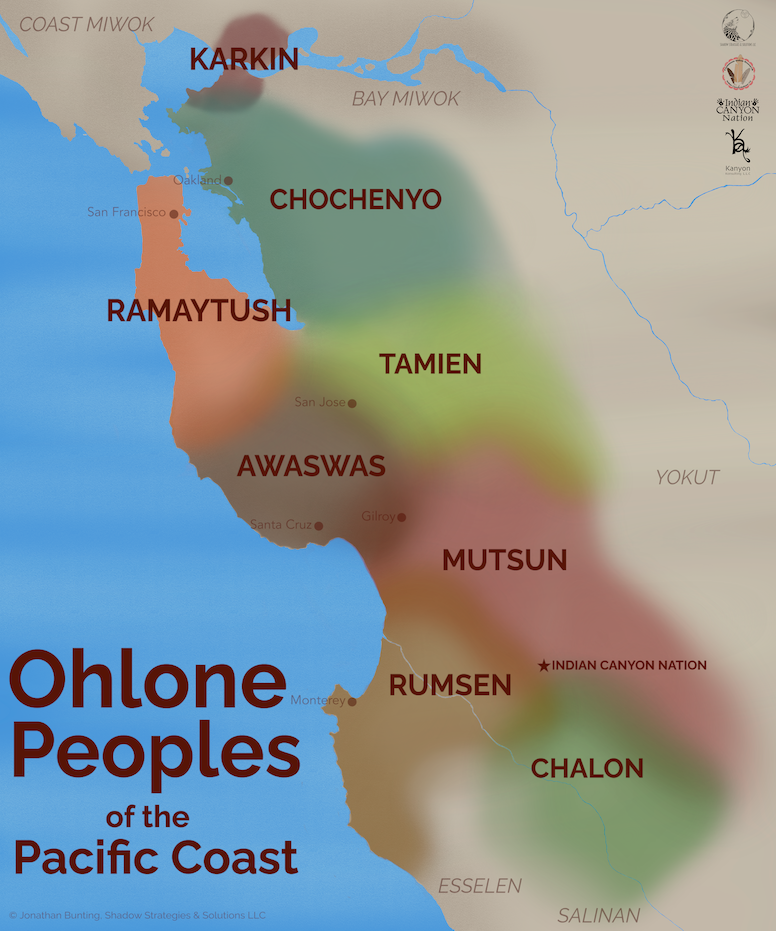Middlebury Institute Land Acknowledgment

A Land Acknowledgement is a formal statement that recognizes and respects Indigenous peoples as traditional stewards of this land and the enduring relationship that exists between Indigenous peoples and their traditional territories. The MIIS Land Acknowledgement was developed September 2023 through a two-year engagement process that included student research, community events and consultation with local Indigenous groups.
Guidelines:
- The statement should not be modified or amended since this is an official statement from the Institute and was created in consultation with the local indigenous community.
- This acknowledgment is read on formal occasions such as commencement and at large community events on campus (over 50 people in attendance and/or open to the community) at the opening of an event.
- It should not be approached as a set of obligatory words to rush through, and it often is followed by a brief silence. These words should be offered with respect, grounded in authentic reflection, presence, and awareness.
- Faculty can include this on their syllabus and will find that in the current syllabus template.
-
If you choose to include this in your email signature, you can either use the full statement or this abbreviated version:
We acknowledge that the Middlebury Institute of International Studies at Monterey (MIIS) sits in the Village of Achasta on the ancestral and unceded land of the Ohlone (Costanoan) Rumsen/Rumsien people, a Rumsen-speaking group. Learn more about how to use a land acknowledgment.
Statement for Ceremonial Use at Events
We pause to acknowledge that the Middlebury Institute of International Studies at Monterey (MIIS) sits in the Village of Achasta [ah-SHA-stah] on the ancestral and unceded land of the Ohlone [oh-LO-nee] (Costanoan) [KO-stah-no-an] Rumsen/Rumsien people, a Rumsen-speaking group. Several contemporary nations, including Esselen [EH-seh-len], call this land home today. The surrounding Monterey Bay region includes lands traditionally inhabited by the Esselen (to the south), Chalon (to the south), Mutsun [MUHT-suhn] (to the north), and Salinan [sah-LEE-nan] (to the east) groups. We honor these groups’ experiences in the past, present, and future, as we work collaboratively with them to protect the land and its inhabitants. Let us take a moment of silence to honor these Indigenous communities, past and present. We give thanks for the opportunity to respectfully share in the bounty of this place, and are working collaboratively to protect it. We are all one in the sacred web of life that connects people, animals, plants, air, water and earth.
Text for Website, Syllabi or Other Written Materials
We acknowledge that the Middlebury Institute of International Studies at Monterey (MIIS) sits in the Village of Achasta on the ancestral and unceded land of the Ohlone (Costanoan) Rumsen/Rumsien people, a Rumsen-speaking group. Several contemporary nations, including Esselen, call this land home today. The surrounding Monterey Bay region includes lands traditionally inhabited by the Esselen (to the south), Chalon (to the south), Mutsun (to the north), and Salinan (to the east) groups. We honor these groups’ experiences in the past, present, and future, as we work collaboratively with them to protect the land and its inhabitants. We honor these Indigenous communities, past and present. We give thanks for the opportunity to respectfully share in the bounty of this place, and are working collaboratively to protect it. We are all one in the sacred web of life that connects people, animals, plants, air, water and earth.
Historical Background:
Beginning in 1769, the Rumsen Ohlone peoples were dispossessed of their lands by Spanish missionaries and settlers who also forcibly expropriated Rumsen labor and perpetrated cultural genocide through coerced baptisms. California’s admission to statehood in 1850 subjected the Rumsen Ohlone peoples to a genocidal “war of extermination”, including slavery, rape, murder for bounty, massacre, and forced removal.
Go deeper and get involved
Consistent with the Institute’s values and commitment to social justice, this land acknowledgment represents one act in an ongoing, long-term process of cultivating meaningful relationships with local Indigenous communities through partnerships, educational programming, events, and additional initiatives. We seek to raise awareness about these Indigenous communities’ ongoing efforts for cultural sharing, education, and social change, as well as historical and present-day injustices they have faced with resilience. We also strive to preserve, create and transmit knowledge so that those who benefit from the dispossession of these peoples may commit to reckoning with history and the contemporary legacies of imperialism and settler colonialism. This acknowledgment has been created in consultation with Indigenous groups and is a living document.
We encourage you to consult the learning and action resources that have informed this statement and overall partnership-building process as well. The contemporary Indigenous nations in Monterey County are: Ohlone Costanoan Esselen Nation (OCEN), Costanoan Rumsen Carmel Tribe, KaKoon Ta Ruk Band of Ohlone-Costanoan of the Big Sur Rancheria, Esselen Tribe of Monterey County, and Rumsen Ohlone Tribal Community.
We would also like to express our gratitude to the Ohlone Sisters, who have closely collaborated with us, generously sharing their meaningful knowledge and wisdom.
